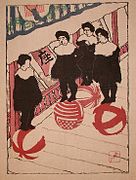Tobari Kogan
Tobari Kogan ( Japanese 戸 張 孤雁 ; born February 19, 1882 in Tokyo Prefecture ; died December 19, 1927 ) was a Japanese sculptor and woodblock artist.
Live and act
Tobari was born as the son of Shimura Kyūzō in Tōkyō, his real first name was Kamekichi ( 亀 吉 ). He later took the mother's name to ensure the successor in her family. In 1892 he began an apprenticeship in a bank and became a secretary. In 1901 he went to America and studied illustration, oil and watercolor painting at various educational institutions, most recently at the National Academy. In 1902 he met the sculptor Ogiwara Morie (1879–1910), who got him excited about sculpture. In 1903 he moved from the academy to the Art Students League, fell ill in 1906 and returned to Japan.
In 1907 Tobari illustrated “Mensch und Natur” (Mensch と 人間 ), “Kukuck” ( 不如 帰 , hototogisu ) and other works for Tokutomi Roka . In 1909 he befriended the sculptor Nakahara Teijirō and the painter Nakamura Tsune . In 1910 he founded the "Kogan shinto nishikie kai" ( 孤雁 新 東 錦 絵 会 )
At the time he learned to model in clay from the sculptor Asakura Fumio (1883–1964). In 1910 he exhibited for the first time at the annual sculpture exhibition organized by the Ministry of Culture. In 1916 he joined the Nihon Bijutsuin Sculptor Department and became a full member the following year. Together with Nakahara he played an important role as a sculptor in the Taishō period . But from a weak constitution, he turned increasingly to watercolor painting and woodcut from 1913 and in 1917 participated in the founding of the "Japanese Society for Printmaking" ( 日本 版画 協会 , Nihon hanga kyōkai ), which was then renamed the following year in "Japanese Society for the creative pressure ”( 日本 創作 版画 協会 , Nihon Sōsaku hanga kyōkai) was renamed. In 1922 he published a textbook on printmaking. Tobari died in 1927 at the age of 45.
Sculptures
- "Foot acrobatics" ( 足 芸 , Ashi-gei ; 1914)
- “Nothing” ( 虚無 , Kyomu ; 1920): Depicted is a pensive old man.
- "Flashes of jealousy" ( 煌 め く 嫉妬 , Kirameku shitto ; 1923): Depicted is a kneeling woman.
Woodcuts
Remarks
- ↑ Kogan shinto nishikie kai: about "Kogan's Society for Splendid Woodcuts of the New East".
- ↑ Correct Ryō'unkaku ( 凌雲閣 ), a 12-story, 52 m high observation tower in Asakusa built in 1890 , which collapsed in the Kantō earthquake in 1923 .
Individual evidence
- ↑ a b Edo-Tokyo Museum (ed.): Kindai Hanga ni miru Tokyo . Exhibition catalog, 1996.
- ↑ a b c Toki no Wasuremono, accessed November 12, 2016
- ↑ a b c d Ukiyo-search, accessed November 11, 2016
literature
- Tazawa, Yutaka: Tobari Kogan. In: Biographical Dictionary of Japanese Art, Kodansha International, 1981. ISBN 0-87011-488-3 .
- Laurance P. Roberts: Tobari Kogan . In: A Dictionary of Japanese Artists. Weatherhill, 1976. ISBN 0-8348-0113-2 .
| personal data | |
|---|---|
| SURNAME | Tobari, Kogan |
| ALTERNATIVE NAMES | 戸 張 孤雁 (stage name, Japanese); Tobari Kamekichi (real name); 戸 張 亀 吉 (real name, Japanese) |
| BRIEF DESCRIPTION | Japanese sculptor and graphic artist |
| DATE OF BIRTH | February 19, 1882 |
| PLACE OF BIRTH | Tokyo prefecture |
| DATE OF DEATH | December 19, 1927 |






